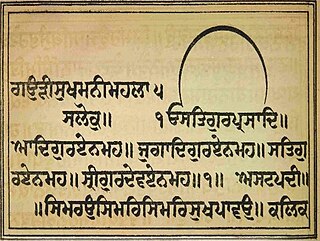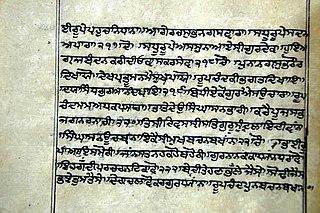Related Research Articles

The Guru Granth Sahib is the central holy religious scriptures of Sikhism, regarded by Sikhs as the final, sovereign and eternal Guru following the lineage of the ten human gurus of the religion. The Adi Granth, its first rendition, was compiled by the fifth guru, Guru Arjan (1564–1606). Its compilation was completed on 29 August 1604 and first installed inside the Golden Temple in Amritsar on 1 September 1604. Baba Buddha was appointed the first Granthi of the Golden Temple. Shortly afterwards Guru Hargobind added Ramkali Ki Vaar. Later, Guru Gobind Singh,s the tenth Sikh guru, added hymns of Guru Tegh Bahadur to the Adi Granth and affirmed the text as his successor. This second rendition became known as the Guru Granth Sahib and is also sometimes referred to as the Adi Granth.

Gurbani is a Sikh term, very commonly used by Sikhs to refer to various compositions by the Sikh Gurus and other writers of Guru Granth Sahib. In general, hymns in the central text of the Sikhs, the Guru Granth Sahib, are called Gurbani. Among Amritdhari Sikhs, a few texts from Dasam Granth which are read as Nitnem, like Tav-Prasad Savaiye and Chaupai, are also considered Gurbani. In Adi Granth, Gurbani is a sound which comes directly from the Supreme and the text is a written form of the same in worldly language and scripts. It is also called Guru’s Bani. Gurbani are explanations of qualities of the Primal Lord and Soul which a Sikh should comprehend and with which they can attain the supreme state.

The Dasam Granth is a collection of various poetic compositions attributed to Guru Gobind Singh. The text enjoyed an equal status with the Adi Granth, or Guru Granth Sahib, in the eighteenth and nineteenth centuries and were installed side by side on the same platform. The Dasam Granth lost favor during the colonial period when reformist Singh Sabha Movement scholars couldn't contextualize the reworkings of Puranic stories or the vast collection of 'Tales of Deceit' Sri Charitropakhyan.

Sukhmani Sahib, known under the title of Gauri Sukhmani in the scripture, is usually translated to mean Prayer of Peace is a set of 192 padas present in the holy Guru Granth Sahib, the main scripture and living Guru of Sikhism from Ang 262 to Ang 296. This Gurbani text was written by the 5th Guru, Guru Arjan (1563–1606) at Amritsar in around 1602. Guru Arjan first recited the bani at Gurdwara Barth Sahib in the Gurdaspur district of Punjab, India.

The principal Sikh scripture is the Adi Granth, more commonly called the Guru Granth Sahib. The second most important scripture of the Sikhs is the Dasam Granth. Both of these consist of text which was written or authorised by the Sikh Gurus.

The Bhatra Sikhs are a group within the Sikhs who originated from the bards of the time of Guru Nanak.

Bhat Vahis were scrolls or records maintained by Bhatts also known as Bhatra. The majority of Bhat Sikhs originate from Punjab and were amongst the first followers of Guru Nanak. Bhat tradition and Sikh text states their ancestors came from Punjab, where the Raja Shivnabh and his kingdom became the original 16th century followers of Guru Nanak, the founder of Sikhism. The Raja's grandson Prince Baba Changa earned the title ‘Bhat Rai’ – the ‘Raja of Poets, and then settled himself and his followers all over India as missionaries to spread the word of Guru Nanak, where many northern Indians became Bhat Sikhs. The majority were from the northern Brahmin caste ,(Bhat ) as the Prince Baba Changa shared the Brahmin heritage. The sangat also had many members from different areas of the Sikh caste spectrum, such as the Hindu Rajputs and Hindu Jats who joined due to Bhat Sikh missionary efforts. The Bhats also contributed 123 compositions in the Sri Guru Granth Sahib (pp.1389–1409), known as the "Bhata de Savaiyye". There hereditary occupations consisted of bards, poets, missionaries, astrologists, genealogists, salesmen.

Balvand Rai also spelt as Balwand and Rai Balvand, was a poet mystic and rabab player in the court of Guru Arjan.

The Guru Granth Sahib, is the central religious text of Sikhism, considered by Sikhs to be the final sovereign Guru of the religion. It contains 1430 Angs, containing 5,894 hymns of 36 saint mystics which includes Sikh gurus, Bhagats, Bhatts and Gursikhs. It is notable among foundational religious scriptures for including hymns from writers of other religions, namely Hindus and Muslims. It also contains teachings of the Sikh gurus themselves.
Bhatt Balh was Brahmin bard in the court of Guru Arjan, whose five hymns are present in Guru Granth Sahib, the holy book of Sikhs.
Bhatt Bhalh was a Brahmin bard in the court of Guru Arjan, whose one hymn is present in Guru Granth Sahib, the holy book of Sikhs.
Bhatt Bhika was a Brahmin bard in the court of Guru Arjan, whose two hymns are present in Guru Granth Sahib, the holy book of Sikhs.
Bhatt Gayand was a Brahmin bard in the court of Guru Arjan, whose 13 hymns are present in Guru Granth Sahib, the sacred scripture of the Sikhs.
Bhatt Harbans was a Brahmin bard in the court of Guru Arjan, whose two hymns are present in Guru Granth Sahib, the holy book of Sikhs.
Bhatt Jalap was a Brahmin bard in the court of Guru Arjan, whose five hymns are present in Guru Granth Sahib, the holy book of Sikhs. Jalap
Bhatt Kirat was a Brahmin bard in the court of Guru Arjan, whose eight hymns are present in Guru Granth Sahib, the holy book of Sikhs. The title Bhatt is given to learned Brahmins.
Bhatt Mathura was a Brahmin bard in the court of Guru Arjan, whose 14 hymns are present in Guru Granth Sahib, the holy book of Sikhs. The title Bhatt is given to learned Brahmins and he is Bhatt Kirat’s brother.
Bhatt Salh was a Sarswat Brahmin bard in the court of Guru Arjan, whose three hymns are present in Guru Granth Sahib, the holy book of Sikhs.
Bhatt Nalh was a Brahmin bard in the court of Guru Arjan, whose 16 hymns are present in Guru Granth Sahib, the holy book of Sikhs.

Bhattan de Savaiye, also known as Bhatt Bani, is a name given to 123 Savaiyas composed by various Bhatts, which are present in Guru Granth Sahib, scripture of Sikhs. According to various scholars, these Savaiyas are eulogies of first five Gurus of Sikhism.
References
- ↑ Dilagīra, Harajindara Siṅgha (1997). The Sikh reference book. Internet Archive. Edmonton, Alb., Canada : Sikh Educational Trust for Sikh University Centre, Denmark ; Amritsar : Available from Singh Bros. ISBN 978-0-9695964-2-4.
- ↑ Page cxx, The Ādi-Granth, Or: The Holy Scriptures of the Sikhs, Ernst Trumpp, W.H. Allen, 1877
- ↑ Page 36, The Encyclopedia of Sikhism (over 1000 Entries), H. S. Singha, Hemkunt Press, 2000
- ↑ Page 8, The Sikh Review, Volume 55, Issues 1-6, Sikh Cultural Centre, 2007
- ↑ "BHATT BANI - Sri Guru Granth Sahib and Guru Gobind Singh's Bani". Thesikhencyclopedia.com. Archived from the original on 23 December 2015. Retrieved 12 October 2014.